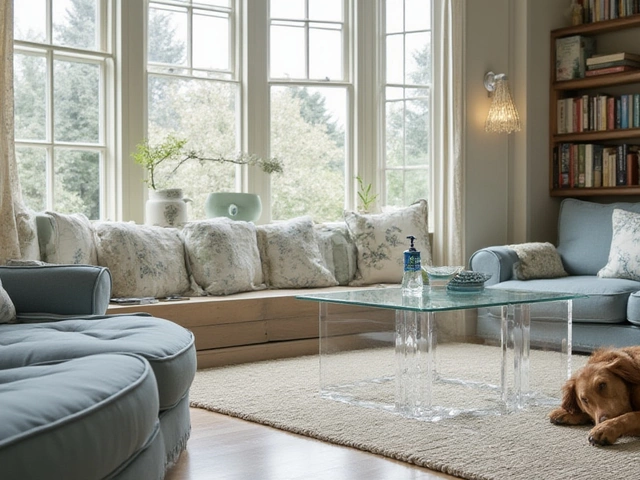 24
Dec,2024
24
Dec,2024
After a long day, there's nothing quite as enticing as sinking into your plush couch, perhaps with a favorite book or a gripping TV series. This cozy corner of the living room often beckons us with the promise of comfort and relaxation. Yet, falling asleep on the sofa, no matter how inviting it might seem, comes with its own set of challenges.
Many people don't realize that snoozing on a couch regularly can have unintended adverse effects. Not only can it lead to discomfort upon waking, but it may also have more long-term implications for your sleep quality and postural health. Plus, consider the wear and tear prolonged rest might inflict on your beloved couch, potentially diminishing its lifespan and aesthetic appeal.
With a little ingenuity, you can make your couch a more conducive space for rest without compromising on health or comfort. In this guide, we'll explore the potential downsides of couch sleeping, offer tips on how to adapt your space, and suggest when a sofa bed might be the perfect solution for those craving the best of both worlds.
- The Lure of the Couch: A Quick Nap Haven
- Health Effects of Couch Sleeping
- The Toll on Your Furniture
- Creating a Bedroom-like Atmosphere on Your Couch
- When to Consider a Sofa Bed for Dual Functionality
The Lure of the Couch: A Quick Nap Haven
There’s an undeniable charm in letting yourself sink into the reassuring embrace of your familiar couch after a hard day’s work. A favorite spot in many homes, the couch often serves as much more than a piece of furniture; it transforms into a symbol of relaxation and respite. Especially when you are worn out, the immediate access to such comfort can make the couch seem like the perfect place to perk up with a short nap. But what exactly makes this piece of household furniture so alluring for a quick snooze?
Firstly, the accessibility of the couch plays a significant role in its appeal. Unlike a bed which is often tucked away in a separate room, the couch is usually in the living space, a central hub of activity. This prime real estate makes it the default option for spontaneous relaxation or a mid-day nap. Additionally, its versatility extends beyond sleeping — you might find yourself reading, watching TV, or spending time with family right there, making it feel naturally like an integrated part of your relaxation routine.
There's also the psychological comfort associated with the couch. For many, the couch is embedded with the aura of familiarity and security. This might link back to childhood memories of family time or a personal space of solitude and creativity. The emotional attachment people develop with their couch can create a sense of well-being and reduce stress rapidly, thus encouraging the idea of napping there. Not to forget, modern couches are often designed with plush, inviting cushions, optimizing the blend of style and comfort.
However, indulging in these quick naps regularly might have unforeseen implications. The couch’s inviting nature can sometimes lead to repetitive sleep patterns that are not conducive to healthy rest. Unlike beds that support your body ergonomically, sofas may lack the necessary support, potentially resulting in poor posture and discomfort over time. An illuminating insight from chiropractor Dr. Emily Peterson suggests, “While couches are perfect for leisure, they might not be ideal for sleep due to their structure and intended use.”
In some interesting statistics compiled by furniture designers, it’s observed that over 60% of households reported using their couch for naps at least twice a month, a testament to its popularity. Nevertheless, while a sofa bed can retain the couch's appeal while offering better support for naps, transforming your living room space with a dedicated nap area can offer similar benefits while maintaining a healthy boundary between relaxing and sleeping environments.
Health Effects of Couch Sleeping
It might seem trivial at first glance, but making a habit of falling asleep on the sofa instead of in bed can have significant consequences on your health over time. To begin with, the design of most couches doesn’t support the natural alignment of your spine as a traditional bed does. This misalignment can lead to chronic back and neck pain, especially if you're contorted into odd positions by limited space. Regularly succumbing to the delights of your living room's enveloping cushions can worsen posture, which is crucial to maintaining spinal health and avoiding muscle strain.
More importantly, the quality of sleep you get on a couch is often less restorative than what a proper bed provides. Sleep science has shown that individuals need the right environment to achieve the deep, restful sleep stages, and the environmental unpredictability of a living room—complete with blaring television sets, household chatter, and inappropriate lighting—can severely disrupt sleep cycles. A disrupted or irregular sleep pattern can lead to daytime fatigue, reduced concentration, and eventually affect mental health.
Moreover, the act of continuously choosing the couch over a bed can influence your overall sleep hygiene. Sleep hygiene refers to the practices that lead to regular, good-quality sleep, and it's as essential to your health as nutrition and exercise. Consistent poor sleep hygiene, such as what often accompanies sleeping on a sofa, might elevate risks for more severe health conditions like heart disease and obesity. A 2023 study published in the Sleep Health Journal noted that individuals with compromised sleep patterns reported higher levels of stress and reduced immunity.
"Sleep is the golden chain that ties health and our bodies together." This quote by Thomas Dekker has never been more relevant. Ensuring that you sleep in dedicated and comfortable environments strengthens every aspect of life from cognitive function to emotional resilience."
Interestingly, not everyone responds the same way to sleeping outside the confines of a traditional bed. What may give one person a crick in the neck may leave another unscathed, at least in the short term. But, given time, the hidden cumulative effects often reveal themselves with persistent insomnia signs or nagging aches—a testament to the body’s need for consistent support and tranquil settings during rest periods. Addressing these factors and acknowledging the subtle impacts of our seemingly innocuous habits stands as a crucial step toward enhancing both immediate comfort and long-term wellbeing.

The Toll on Your Furniture
Your couch, the beloved centerpiece of your living space, bears witness to countless moments of relaxation and socialization. However, habitually using your couch as a makeshift bed can gradually wear it down, and before you know it, the plush sanctuary might start showing signs of distress. One of the most immediate effects of constant use as a sleeping area is the deterioration of the cushions. Couch cushions are designed for sitting, which distributes weight differently compared to lying down, leading to uneven wear. Over time, this can cause the cushions to lose their shape and firmness, turning your couch from a snug paradise to a lumpy eyesore.
Additionally, the fabric or upholstery itself is put under unusual strain. Frequent compressing and decompressing of both the cushion foam and the outer fabric can lead to stretching, sagging, and eventually tearing. This isn't just a matter of aesthetic degradation; it can also render the couch less comfortable and inviting. Keeping a couch in such a state might also make occupants more prone to uncomfortable seating positions which can exacerbate issues with worn-out furniture. An important point to note is that certain materials are more prone to damage, like natural fibers which may fade or wear out faster than synthetics.
The frame of the couch is another silent sufferer. Sofas are designed to support a certain kind of weight distribution. Regular conversion into a bed might lead to joint loosening or even breaks in the supportive beams. This internal damage can often go unnoticed until it's too late, resulting in costly repairs or complete replacement. It's quite astonishing how a piece of furniture can develop creaks and sags given just a few months of nightly use. And it's not just about structural wear; dust mites and other allergens are more likely to build up in couches used as beds, posing health risks.
Interestingly, upholsterers notice that even the nicest fabric treatments can fade when exposed to the nightly regime of heat and pressure. As quoted by interior designer Thomas Jay, "The couch is meant to be the crown of your living space, not the cornerstone of your bedroom," realizing the aesthetic importance a couch holds in a well-organized living area. Regular maintenance like fluffing cushions and rotating them can help maintain them longer, but sometimes it's not enough against the nightly abuse. Adding a sofa bed to your home might mitigate these impacts while preserving the eye-catching appearance of your couch.
Avoiding these issues requires proactive care. Avoid sleeping on the same side of the couch if you must nap there, and invest in high-quality protective covers that can preserve the upholstery underneath. For those whose lifestyles revolve around the couch due to limited space, it's worth considering furniture specifically designed for dual use, like sofa beds. These pieces are built to endure the strains of constant adjustment and can save both discomfort and money in the long run, offering an exciting blend of functionality without the impending toll on the beloved couch.
| Impact | Symptoms | Solution |
|---|---|---|
| Cushion Sagging | Loss of shape | Regular rotation and fluffing |
| Fabric Damage | Stretching, tears | Use protective covers |
| Frame Damage | Creaks, breaks | Limit weight and role change |
Creating a Bedroom-like Atmosphere on Your Couch
Transforming your couch into a cozy, inviting sleeping area can be quite the art form, requiring not just clever arrangements but also a deeper understanding of how to cater to comfort. The goal is to simulate the conducive sleep environment typically confined to a bedroom. This doesn’t mean you have to sacrifice your home’s style or functionality, but a few thoughtful tweaks can make a world of difference—both for sporadic nappers and those who occasionally need their living room to double as a home comfort zone.
Begin by focusing on the textiles. Much like a bed, your couch can benefit from the right layering. Start by draping a soft, breathable throw blanket over your couch. Cotton or wool blends work best, as they regulate temperature without retaining too much heat. Incorporate plush cushions in varying densities to emulate the support of bed pillows—ideally, some softer options for the head and firmer ones for lumbar support. Don't hesitate to splurge on a luxurious throw to keep your body warm as you drift off in your living area's embrace.
Lighting is another crucial element that often gets overlooked. Most living rooms are designed for social gatherings rather than sleep-friendly spaces, so adjusting the luminosity can help transition the atmosphere. Consider investing in adjustable or dimmable lamps. By reducing harsh lighting, you foster a relaxed ambiance that can make a big difference in how quickly you fall asleep. Additionally, blackout curtains can effectively block street lights, an excellent addition if your couch is near windows.
Let’s not forget about the scent. Much like pillow sprays for beds, consider the olfactory environment of your living area. Aromatherapy can subtly transform the mood of your living space. Scents such as lavender, chamomile, or sandalwood are known to promote relaxation and better sleep. Using a reed diffuser or an essential oil diffuser can distribute these calming scents evenly, enveloping you as you unwind.
Sound, too, is a factor to address. A study by the National Institute for Health Research emphasizes the importance of controlled acoustics for restful sleep. You might consider a white noise machine or soft ambient music to drown out disruptive sounds from urban life or even a noisy household. This can make your sofa bed experiment more successful, providing a seamless transition into sleep akin to being in a dedicated bedroom.
For those inclined towards technology, smart home devices can be a terrific ally. A simple voice command could adjust your thermostat, dim your lights, or play a soothing playlist, creating a seamless evening routine. However, balance is key; blue light from screens can inhibit sleep, so ensure electronic use is limited or filtered during your wind-down.
"A bedroom is personal, but creating a multi-functional area in your living room that mimics its serenity is an exercise in balance," says renowned interior designer Laura Savoie. "When done correctly, it respects the space’s original intent while cleverly adapting to new needs."
In exploring these strategies, remember not to compromise the primary function of your couch. Maintaining its design integrity involves folding throws and tidily piling pillows when not in use. By integrating a sofa bed into your home’s design, you remain ready for guests or those unexpected nights when the couch becomes your haven for rest, all the while preserving a polished appearance during the day.

When to Consider a Sofa Bed for Dual Functionality
Choosing whether it's the right time to invest in a sofa bed can seem like a daunting decision. Yet, in creating a space that is both aesthetically pleasing and functional, a sofa bed offers an unparalleled versatility. For those living in compact apartments or homes with limited guest rooms, it provides an essential solution. Picture this: a living room that can transition effortlessly into a comfortable sleeping area without compromising on style or comfort. A sofa bed can serve as the perfect piece of furniture to entertain guests in the day and provide them a cozy resting spot at night.
A prime reason for considering a sofa bed is its space-saving prowess. Many urban dwellers face the challenge of making the most out of constrained space, and traditional beds can dominate a room entirely. A sofa bed not only serves as a seating option but also morphs into a bed when needed, helping maintain a sleek and uncluttered environment. With the correct choice, it ensures both form and function, satisfying your home’s dual necessities without having to sacrifice precious square footage. This dual functionality becomes a lifesaver during holiday gatherings when guests arrive in droves.
The versatility doesn't just stop at accommodating guests. Consider the transformative power a sofa bed has in a home office. With remote work becoming increasingly prevalent, many people are converting spare spaces into offices. A simple fold-out bed option easily converts workspaces back to guest rooms, ensuring that business and pleasure can coexist harmoniously. When people spend their waking hours in these areas, having the choice to unwind on a comfortable bed allows them to decompress without swapping rooms, enhancing their productivity and relaxation.
Now, thinking beyond the versatility of a sofa bed, it often features a range of aesthetic options that can complement your home’s decor. From sleek modern designs to classic Victorian styles, the choices are vast and varied, ensuring you find something that matches your taste. Studies suggest that making design choices that reflect one’s personality can greatly impact mood and overall happiness within the home. Embrace the chance to marry practical utility with personal expression through the right sofa bed choice.
When considering a sofa bed, one must account for the frequency of use and its primary function in your home. Is it primarily for occasional guests or a regular sleeping space for a family member? The market offers models with diverse mattress quality, ranging from basic foam to luxurious memory foam or spring mattresses. Selecting the right mattress will significantly impact sleep quality, turning it from a necessity to luxury. If your couch often doubles as a bed, investing in a high-quality mattress is non-negotiable.
Lastly, budget considerations can’t be ignored when bringing home a sofa bed. While there is a price range to suit every pocket, remember that this piece will see significant use, and durability should not be compromised to save a few dollars. A robust sofa bed with a reliable mechanism ensures longevity, supporting more than just restful sleep—it upholds your investment's value. The flexibility that a sofa bed brings is critical for dynamic living spaces, adapting as your lifestyle evolves.




